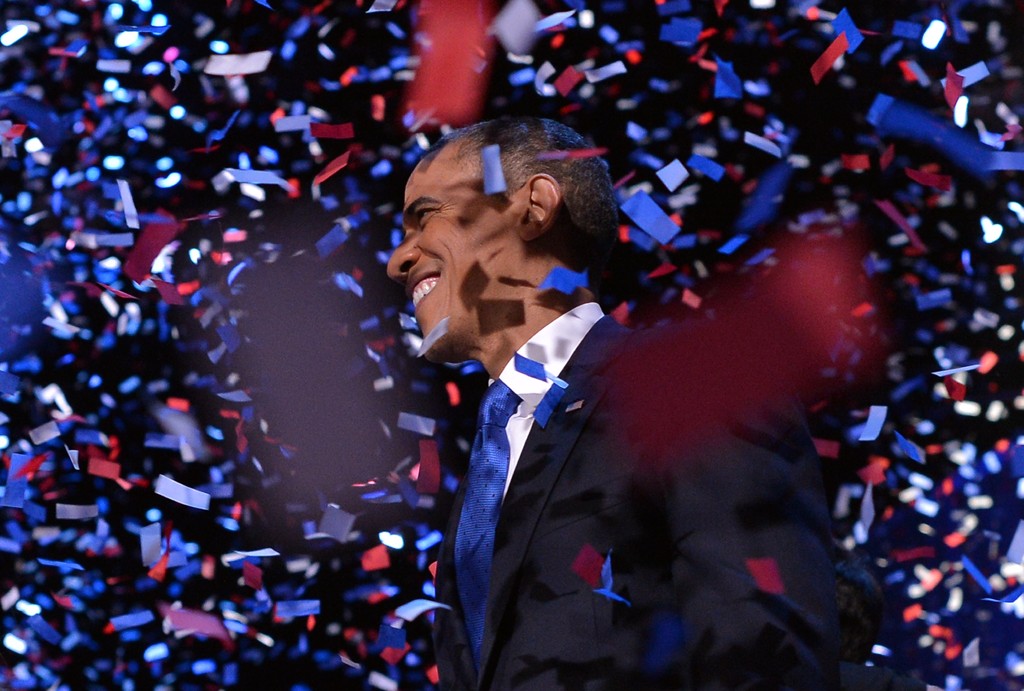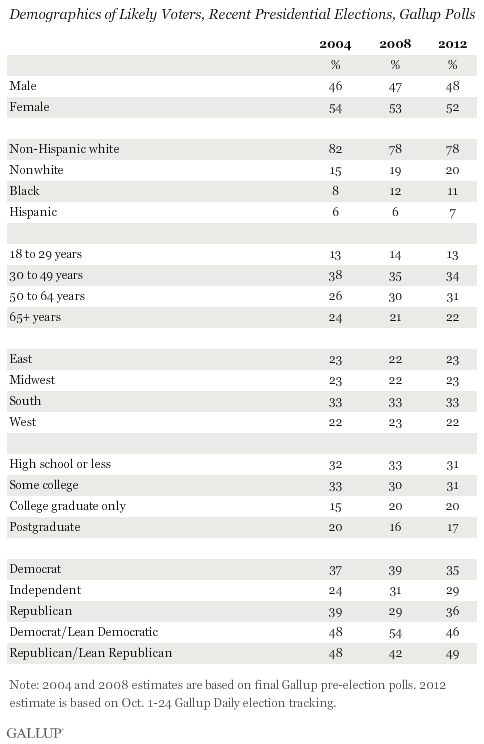
After spending months staring at the electoral map and trying to puzzle out which states might go for President Obama, which for Mitt Romney and by how much, we thought it was worth sorting through the actual results to find the 10 states where the two men ran closest.
These 10 states are likely to be the swing states of the future, the places where both parties — in presidential elections but also midterm races — target their time and money in hopes of swaying a relatively evenly divided electorate.
Before we get to the list of states, a few fun facts:
* Of the 10 states, Obama won nine of them. (North Carolina was the lone Romney victory.)
* Only one — Florida — appears likely to be decided by less than a single percentage point. (At the moment, Obama leads Romney by 0.6 percent with 99 percent of precincts reporting.) That’s a change from 2008 when three states were decided by less than a point: Missouri (0.1 percent), North Carolina (0.4 percent) and Indiana (0.9 percent).
* Of the three states where Romney pledged to expand the map — Michigan, Minnesota and Pennsylvania — only one (Pennsylvania) makes our top 10 closest races. In Michigan, Obama won by 8.5 points, while he carried Minnesota by 7.6 points.
Without further ado, here are our top 10 closest states, ranked from narrowest margin — by percentage — to widest. If less than 100 percent of precincts are reporting in a state, according to the Associated Press, that is noted in parentheses.
1. Florida: 0.6 percent (Obama 49.9, Romney 49.3.)
2. Ohio: 1.9 percent (Obama 50.1, Romney 48.2)
3. North Carolina: 2.2 percent (Romney 50.6, Obama 48.4)
4. Virginia (99% reporting): 3.0 percent (Obama 50.8, Romney 47.8)
5. Colorado: 4.7 percent (Obama 51.2, Romney 46.5)
6. Pennsylvania (99% reporting): 5.2 percent (Obama 52, Romney 46.8)
7. Iowa: 5.6 percent (Obama 52.1, Romney 46.5)
8. New Hampshire (99% reporting): 5.8 percent (Obama 52.2, Romney 46.4)
9. Nevada (99% reporting): 6.6 percent (Obama 52.3, Romney 45.7)
10. Wisconsin: 6.7 percent (Obama 52.8, Romney 46.1)
The future of compromise: So the government of 2013 will look a lot like the government of 2012 and 2011, but will there be more compromise?
We’re getting conflicting signals.
One potentially major shift is House Speaker John Boehner (R-Ohio) saying his party may be open to revenue (read: tax) increases as a part of budget dealing.
“For purposes of forging a bipartisan agreement that begins to solve the problem, we’re willing to accept new revenue, under the right conditions,” Boehner said Wednesday.
Whether you’ve noticed it or not, Facebook has likely changed your brain. You get a rush of dopamine — that same chemical that kicks in when you’re rewarded — when you see a notification. People with more than 229 friends tend to have larger orbital prefrontal cortexes, the area for social behavior and […]
Did you know that the majority (51 percent) of U.S. Christmas holiday shoppers will do most of their purchasing in November, and almost one third (29 percent) will have started before October? 68 percent expect to spend the same or more as last year, and almost two-thirds (63 percent) will do the majority […]
Good news! That work project is almost complete, and you find yourself with a few minutes to kill. Heck, you’ve earned it. So, what’s the first thing you do? Have a quick look at Twitter? Read the latest posts from your friends on Facebook? Browse all that goodness on Pinterest? Sure you do. Nothing wrong […]
Have you been tweeting about the US elections? If so, you’re part of the 39 percent of US adults who use social media to discuss politics. So how is all of this online political activity affecting the presidential elections? OpenSite has prepared this infographic that explores the impact that social media has had on […]
Two pollsters, Gallup and Rasmussen Reports, are projecting Republican voters to have a slight advantage on November 6 over Democratic voters. When they add likely voters leaning towards one party or another, they find an electorate that is marginally more Republican than in 2004, when voters narrowly reelected incumbent President George W. Bush. Gallup projects that the demographics of the electorate will nearly mirror 2008, but party support favors Republicans more than the last two presidential election cycles.
In 2008, Gallup projected that self-identified Democrats would outnumber Republicans by 39 to 35 percent. When voters who leaned Democratic were included, they projected an 12 point advantage for Democrats. This slightly overestimated the final national electorate, in which Democrats enjoyed wide but slightly smaller advantage over Republicans. In 2004, Gallup found party identification favoring Republicans by 2 points, which virtually mirrored the final national vote in which Bush won by just over 2 percent.
This year, Gallup finds a one point Republican advantage over Democrats, at 36 to 35 percent. They also find that self-identified independent voters will make up 29 percent of the electorate. However, when leaners are included, Republican voters will outnumber Democratic voters by 49 to 46 percent.
This finding is close to what Rasmussen Reports saw in their August/September average of party identification. Their surveys found Republicans dominating the electorate with Democrats trailing their 2004 and 2008 turnout totals. Independent voters, which most national polls show favoring Mitt Romney by wide margins but backed President Barack Obama in 2008, approximately mirror their 2008 turnout totals (the Washington Post/ABC News tracking poll on Thursday showed Romney with a 19-point advantage over Obama among independent voters).
Twitter drives the most traffic of all the major social networks, but it’s Facebook that generates the most revenue, reveals a new study by Eventbrite. Shares made on Twitter trigger, on average, 33 visits to websites, compared to 14 for Facebook and 10 for LinkedIn. But the value of that share skews heavily in […]
We’re just a couple of weeks away from the 2012 U.S. presidential election and, as the respective campaigns of President Barack Obama and Republican nominee Mitt Romney heat up, the use of social media has never been more important, both in raising awareness of policies and targeting potential voters. And for both candidates, […]

DOHA — I’m currently on my way from New York City to Tanzania, where I’ll visit "the best hotel in the world" and some lesser-known game reserves in the southern part of the country.
After a 12-hour flight from JFK International Airport, I’ve spent the last six hours in Qatar Airways’ premium terminal at Doha International Airport, and there’s almost nothing to do here but eat.
Eating has pretty much been the theme of my trip since I arrived at JFK last night around 9 p.m. It’s my first time flying business class, and I’m quickly realizing that one of the biggest differences between a coach ticket and a business class ticket is the food.
First there was the buffet in the Admirals Club at JFK’s Terminal 8, which featured everything from roast chicken to pasta salad even though it was nearing midnight by the time I left.
And from the moment I sat down on the first leg of my flight on Qatar Airways, I was plied with food. Dinner, which was served around 1 a.m., was a five-course meal that included an amuse bouche and cheese course. The airline is known for its food and service — it was recently named the world’s best airline by Skytrax — but I still didn’t actually expect to enjoy the taste of my airplane meal.
Now I’m Qatar Airways’ holding pen for business class travelers, and it’s pretty impressive. The expansive room has several seating and rest areas, as well as a business center, kids’ playroom, and clinic. There are no blaring speakers, either — an airline employee walks around the entire center and quietly informs travelers every time a flight starts boarding.




